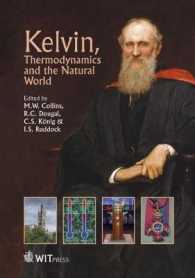- ホーム
- > 洋書
- > 英文書
- > Politics / International Relations
基本説明
Explores the joint Franco-German production of a state-of-the-art and very expensive military helicopter, the Tiger helicopter.
Full Description
Ulrich Krotz's Flying Tiger takes a relatively obscure episode--the joint Franco-German production of a state-of-the-art and very expensive military helicopter, the Tiger Helicopter (used in the James Bond film Goldeneye, incidentally)--to make a groundbreaking theoretical contribution to international relations scholarship.
The rivalry between Germany and France in the nineteenth and twentieth centuries is of course well known. It was directly or indirectly responsible for four cataclysmic wars, and until relatively recently, the idea that these two states could become close partners seemed implausible. Yet following World War II and the birth of the European Union, they became the closest of allies. In fact, they collaborated for three decades on the most sophisticated weapon that the EU has produced: the Tiger. How did this occur, and what does this happy albeit unforeseen outcome tell us about how interstate relations really work?
Through the lens of the Tiger, Krotz draws from two theoretical approaches--social constructivism and historical institutionalism--to reframe our understanding of how international relationships evolve. International relations scholars have always focused on relations between states, yet have failed to think in any sustained way about how interstate relationships both remold domestic realities and derive from them. How does a relationship between states impact upon a state internally? And how do the internal institutional dynamics of a state limit such relationships? While International Relations scholars have touched on these issues, until now no one has provided a sustained, finely grained, and historically informed analysis that explains how international relations socially constructs domestic realities and how in turn domestic politics and institutions structure interstate relationships.
Krotz's account of how the Tiger project was funded and how the device was built perfectly illustrates his theoretical claims about the dialectical relationship of 'high' interstate politics and 'low' domestic politics. Two famous rivals completely reshaped their relationship through a complicated, decades-long process in which the nuts and bolts of domestic politics--approvals for state funding as well as laws regarding corporations and technology transfer, for instance--were instrumental in creating a new reality.
Contents
TABLES AND FIGURES; ABBREVIATIONS; ACKNOWLEDGMENTS; APPENDIX; COSTS, PHASES, NAMES; NOTES; BIBLIOGRAPHY; INDEX








